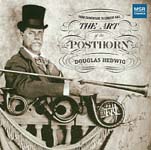
The Art of the Posthorn. Douglas Hedwig Eb, F, A and Bb posthorn, F posthorn with tonehole, valved posthorn; Jorge Parodi, piano. MSR Classics MS 1184. Recorded January and February 2006 at Bugler's Holiday Studio, Patterson, NY. Available through the MSR Classics website www.msrcd.com/1184/1184.html in addition to all major online CD websites; including Amazon, Barnes and Noble, and many others.
What Doug Hedwig has presented in this CD in not only his work as a performer and researcher, but a sort of auditory museum exhibit on the practical and musical uses of the posthorn in the 1800s, presented with the social context in which it thrived. The ten accompanied, solo pieces are bookended by the posthorn signals that influenced or inspired them and by unaccompanied posthorn songs. The instruments used range through several differnet keys and include instruments with 1 tone-hole and valved posthorn. Taken together with informative liner notes explaining the sources and roles of the various selections, the listener is treated to a wonderfully three-dimensional view of the instrument.
The performances are lively and very musical. At times listening to the signals I wondered if a player on a speeding carriage could manage such a level of finesse. The songs call up images of a jocular postillion entertaining the waiting or traveling public as the coach made its way through big cities and small towns. The accompanied solos are charming and tuneful, played with a grace and lilt that complements the idioms of the instrument. The posthorn, before the addition of holes or valves, was a fairly simple instrument limited to bugle-like melodies, but the introduction of one tone hole added to the spectrum of notes available and a new timbre choice, a haunting resonant sound reminiscent of the cornetto. On the last piece of the album, the Post Horn Polka formerly attributed to J. Strauss, the posthorn enters the arena of modern valved brass instruments with full chromatic possibilities.
The value of this work for modern teachers and perfromers lies in its ability to broaden our understanding of the context that our instruments developed from, especially since as modern performers we are often asked to emulate these instruments. There is also value in understanding the traditions and methods of playing the posthorn and the educational methods and systems associated with it, since even the most modern of brass players still contends with the same issues as the player of a simple posthorn or bugle: air, tone, range and endurance. The solo pieces on this CD also present a repertoire appropriate for any stage or concert hall, and I found myself wondering about different places they could be programmed, the only drawback being that the limited notes available on the non-holed instrument result in a certain similarity in the solo pieces. While I wouldn't want to listen to an entire concert of posthorn solos, one or two in a program would be welcome and refreshing. The way that they are presented on this CD, with signals and songs in between, works very well.
Many thanks to Doug Hedwig for shining some light into the rather dark corner the posthorn occupies in the minds of most brass players!
-- Flora Newberry



